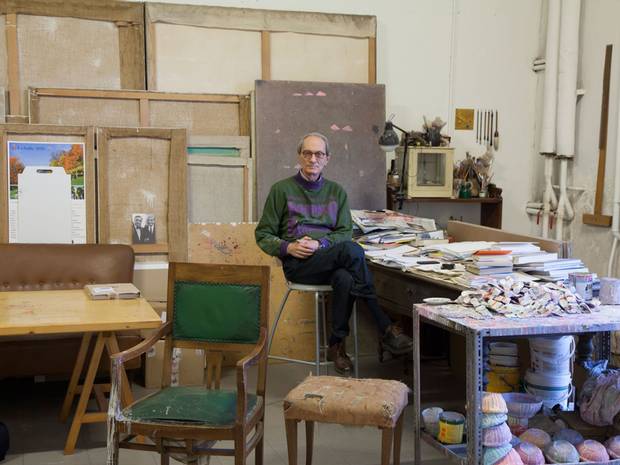Casey Kaplan

![]()
In the studio with Giorgio Griffa
‘My last studio was bigger and brighter. Here, I had to draw myself out of sadness’
By Karen Wright
January 2015
Giorgio Griffo was born in Turin in 1936. He moved to this current studio in a large block near the city centre ten years ago, having previously used a room in his flat that was “much bigger and brighter”. It would be hard for it not to be brighter, as the room we are in has no windows, its only illumination an obscured glass door to prevent people peering in. He admits he was so depressed after he moved in that, “I had to draw myself out of sadness”, pointing to a drawing about the addition of yellow. He also got himself some daylight bulbs to warm the light.
The Seventies block – a former storage facility for tyres – was converted to studio spaces when the tyre manufacturers left. The studios are now rented out, not only to artists, but to designers and architects. There is a commercial kitchen here as well, which supplies restaurants and caterers and now has also opened a small restaurant in the courtyard, where I had a delicious lunch.
Griffo comes to this modest room every day, working away at his semi-abstract works on upstretched canvas, all containing conceptual reasons and logical rationale. He is currently working on a series that is lying on the floor. He has been experimenting with a new canvas. It is not pure cotton, but it is mixed with a bit of synthetic material – he laughs, pointing out how the colour has leached from the lines. “That is up to the artistry of the materials, not of the artist.”
Griffo has been experimenting with the mathematical Golden Section for many years, as “it goes numerically far beyond what we can comprehend”. He includes it in his canvases in some way, along with a number of doodles and squiggles, each having some meaning. But ultimately, he points out that “every art of every time… physically enters the unknown.”
On another wooden easel are some beautiful small collages. “These are experiments. I have been working on the same paper that I get in large sheets for many years, and when I moved, one piece tore and so I ripped it off and made these small works. I would not sell them, but I have given one to a friend.” I point at his shoes, covered in paint; his jeans, also, have a tide mark of colour. There is something desirable about the vestiges of the painter. The bowls that contain his water and paint – he has been using only watercolour and Liquitex acrylics since 1967 – are thickly caked with colour.
Griffa is modest in his demeanor, but has recently been having a moment of rediscovery with a show at Macro in Rome and a gallery show in Rome. I ask him if he likes working in the complex with other artists and he responds: “It is a beautiful thing. I have always worked in isolation and here is a common house. It is a beautiful idea – a curious family with no father or mother.”